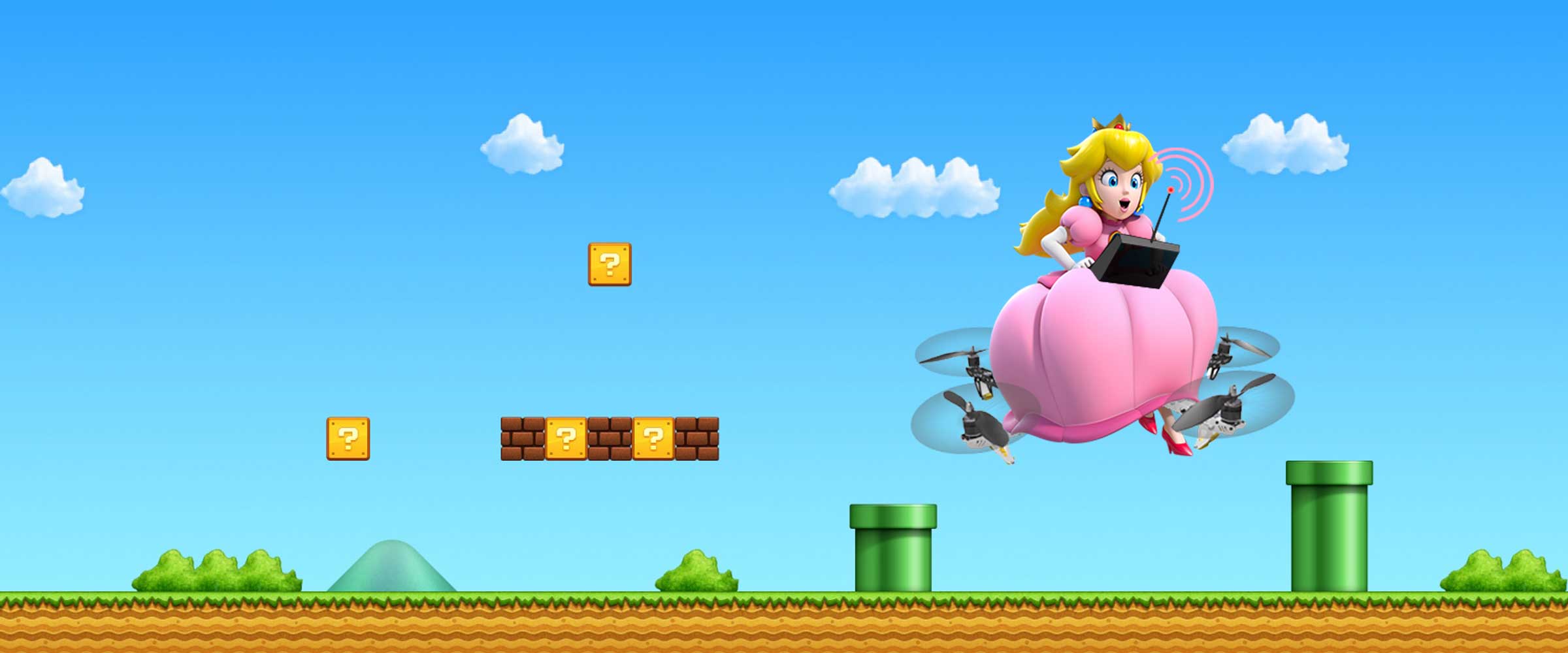
How does Princess Peach float?

One of video games’ most famed princesses, Princess Peach has been kidnapped at least 12 times and has likely developed Stockholm syndrome along with bipolar disorder (based on her emotion-focused/mood-swing attacks in Super Princess Peach). While the Toad security force’s efficiency as a protective agency is questionable, Peach’s ability to float has been unwavering, present in every single Mario game where she is a playable character. How does she do it?
Peach is not alone in her hovering abilities. There are many female characters in popular media who have used either parachute petticoats or parasol parachutes to glide to the ground like an angel. Peach started out floating in Super Mario Bros. 2 without any implement other than her dress, which is the parachute petticoat trope used in Lilo & Stitch comics, Alice in Wonderland, Chitty Chitty Bang Bang, The Adventures of Bullwhip Griffin, Superfolks, Mistborn, Jack-of-all-Trades, America McGee’s Alic, BlazBlue, Muppet Babies, the Backyardigans, Rugrats, Popeye, Animaniacs and even Jem and the holograms.
1. Does the Parachute Petticoat have a basis in reality?
Although I couldn’t find definitive evidence of tests of the petticoat, there is anecdotal support through the story of Sarah Ann Henley. Heartbroken after her fiancée broke off their engagement, the 22-year-old barmaid decided to leap off the Clifton Suspension Bridge in Bristol to commit suicide. She was wearing a crinoline dress at the time, a very stiff fabric entwined in horse hair and often drawn in the form of a strong cage. This rigid canvas caught the wind and carried her away from the river 75 meters below, and instead brought her toward the muddy banks of the Avon River. Rescuers brought her out of the mud and took her to the hospital, where she was treated for internal injuries. The whole affair passed so deeply into legend that William E. Heasell immortalized her in a verse of his song, An Early Parachute Descent in Bristol:
Once in Victoria’s golden age
When crinolines were all the rage
A dame in fashionable attire
Would change her life for one up higher
So up to Clifton Bridge she went
And made a parachute descent
But though, ’twas not the lady’s wish
A boatman hooked her like a fish
And thus a slave to fashion’s laws
Was snatched from out of Death’s hungry jaws
This story’s true I’d have you know
And thus it only goes to show
While this is certainly encouraging evidence for Peach’s hovering habits, it was a 75 meter fall, and Sarah still suffered internal injuries. The wind requirement might even make such everyday use of the parachute petticoat unreliable.
Perhaps that’s why, in later games, Princess Peach made use of an umbrella, à la Parasol Parachute.
2. Could a real-life Peach rely on a Parasol Parachute?
 Again, Mario’s (or Bowser’s?) love is not alone in her use of an umbrella to improvise a parachute. It’s used often in manga, and has been donned by Batman’s Penguin, James Bond, the Aristocats, Jackie Chan, Inspector Gadget, Calvin & Hobbes, Tobias in Arrested Development, Lemmings and Chip ‘n Dale, Rescue Rangers. When there’s danger.
Again, Mario’s (or Bowser’s?) love is not alone in her use of an umbrella to improvise a parachute. It’s used often in manga, and has been donned by Batman’s Penguin, James Bond, the Aristocats, Jackie Chan, Inspector Gadget, Calvin & Hobbes, Tobias in Arrested Development, Lemmings and Chip ‘n Dale, Rescue Rangers. When there’s danger.
Oh, and let’s not forget Mary Poppins! Professional scientist and amateur pro-skier Erik Roner decided to put Mary Poppins’s endless purse money where her mouth is. Or into the upper layers of the troposphere.
He dove into the sky with an umbrella. This video is a must-see. A spoonful of chamomile won’t help the adrenaline go down, Ms. Poppins. Although the umbrella’s tumble through the air didn’t end in the most delightful way, Erik Roner’s jump did. Score one point for brave scientists who happen to do sports occasionally. Minus one point for the viability of the parasol parachute. But could you do it if it was built properly?
Unfortunately, the ever-thorough, peer-review-eluding Mythbusters team has debunked the idea of using of an umbrella to break one’s fall. A fall of 18 meters was demonstrated to be slowed by an umbrella, but ultimately still deadly. The best thing the parasol could offer would be to keep a princess upright as she plummets.
On a beautiful related sidenote, Patricia Almeida and Diana Tavares captured these gorgeous photos of an “umbrella roof” in Agueda, Portugal. Were the designers similarly looking to the sky as to the umbrella’s potential?
So the conventional attire doesn’t appear to make the cut for the pale pink lady. Her dress is pretty large, however — could she be hiding some advanced technology within her underskirt? Pocketing some propellers in her pannier?
3. Can Princess Peach levitate?
First of all, we’ll disregard the methods used by mystics, if only because Peach has become demonstrably more ditzy throughout the years of her evolution.
Maglev
Magnetic levitation, the effect observed when like poles of a magnet are brought together, is already used in high-speed bullet trains in at least China and Japan. Regardless of the mechanism by which the magnetism is generated, the effect requires magnets on both surfaces. So even if Peach had magnets up and down the cage of her crinoline, she would eventually encounter a surface where magnets aren’t present. In fact, she often floats on grassy plains. So Maglev’s out.
Casimir Effect
The Van der Waals’ force, a result of asymmetries in the electron clouds around atoms and random fluctuations, is a very weak force that can create repulsive or attractive forces. The Casimir Effect is something similar which only occurs at very close distances where quantum field effects come into play, and where similar fluctuations in quantum fields give rise to net force. It’s responsible for friction at the nanoscale, and very weak until you get sufficiently close — at a distance of about 100 atoms, it can exert a pressure of about an atmosphere. Scientists have figured out a way of making it repulsive, and the first application will probably be to create a “gap” between nanostructures that need to glide past each other.
While this effect is often quoted for its potential in levitation applications, the fact that Mr. Casimir flexes his muscles only when you get really close doesn’t bode well for macroscopic real-world applications. At least for now. So that rules this form of levitation.
Peach PentaCentacopter
The only technological option we’re left with is traditional lift-generation using rotors, like helicopters. It doesn’t seem that far out of the realm of possibility to imagine a throng of small rotors spinning to generate enough lift to raise our dainty princess, does it? Volo has, after all, demonstrated the use of an 18-rotor copter that’s functional. Peach’s floatation even looks like it’s pushing up from the rim of her dress in the newest Super Mario 3D World:
To get a definitive answer, we look to physics, specifically the equation for lift:
L = 1/2 p v^2 A C
That is, Lift (L) is equal to half the air density (p) times the square of the rotor velocity, times the planform area and the coefficient of lift. The maximum coefficient of lift for a typical cambered airfoil is about 1.75 (tilted at 15 degrees), and if we assume a modest rotor of 15 cm diameter spinning at roughly 3,000 RPM with normal air density (1.184 kg/m^3), we get a planform area of 0.0015 square meters, and an average velocity of 23.56 m/s. This all works out to 0.86 N of lift.
If we take a rough stab at Peach’s weight, say 100 lbs or 45 kg, then that equates to 441 N at ground level. With the above estimate of rotor lift, we’d need about 500 of them to generate enough lift for Peach to stay afloat. And that’s not counting the weight of the driving motors themselves, or their power source. Figuring out a way to jam 500 rotors into Peach’s dress is… a bit problematic, though I suppose it could be done…
Unfortunately, it doesn’t look like she’s got a swarm of sharp rotors spinning away under her dress, although the topic of what lay cached beneath the crinoline is a subject of rich depth in Internet communities.
Conclusion
For the time being, it appears that Peach either has some top-secret military technology stolen during her long hours in Bowser’s research labs, or that she’s an entity whose abilities extends beyond our current understanding of the physical world.
Do you have a theory about how Peach floats? Or her bizarre psychology? Let me know in the comments!


















Two words: Bad gas.
I have a theory.its called reality. It’s fictional,. it’s not real. Peach doesn’t really exist, she’s a fictional character.
it’s the f***ing super mario universe
In Super Mario Bros. in the manual Peach was told to have magical abilities, and if you look in Super Mario 3D World when she uses the boomerang power up she is wearing no dress/skirt, so no drag or air can make her float, but you can see that you can that she can still float, and in the same pose she does when she does wear her dress, and with evidence from Super Mario Bros. we can conclude that Peach uses her magic to float for a few milliseconds.
Its so obvious, in smb1 bowser kidnaps peach becaus she is the only one who can undo a curse he put on the mushroom kingdowm SHE. IS. MAGIC. thats how she floats.